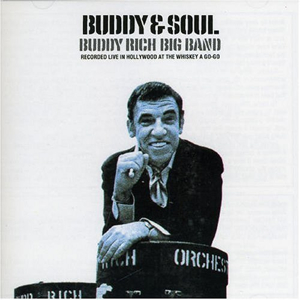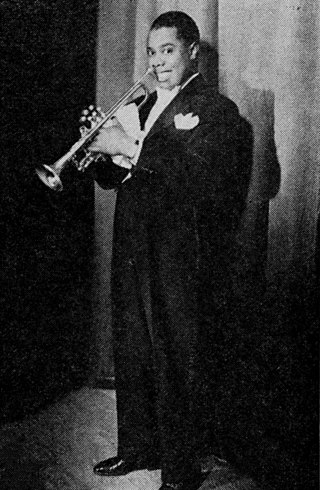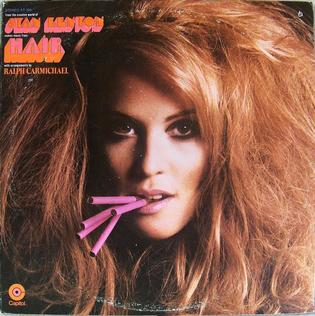Related Research Articles

This 1956 recording based on George Gershwin's opera Porgy and Bess was the second "complete" recording of the opera after the 1951 version, and the first recording of the work to feature jazz singers and musicians instead of operatic singers and a classical orchestra.

The Preservation Hall Jazz Band is a New Orleans jazz band founded in New Orleans by tuba player Allan Jaffe in the early 1960s. The band derives its name from Preservation Hall in the French Quarter. In 2005, the Hall's doors were closed for a period of time due to Hurricane Katrina, but the band continued to tour.
Gordon Goodwin's Big Phat Band, or simply The Big Phat Band, is an 18-piece jazz orchestra that combines the big band swing of the 1930s and 1940s with contemporary music such as funk and jazz fusion. The band is led by Gordon Goodwin, who arranges, composes, plays piano and saxophone. Since its origin, the Big Phat Band has received several Grammy Awards and many Grammy nominations.
Caribbean Jazz Project was a Latin jazz band founded in 1993. The original group featured Dave Samuels, Paquito D'Rivera, and Andy Narell. After their second album, D'Rivera and Narell left the group, although both returned as guest stars. Under Samuels' leadership, the group explored different genres of latin jazz with a changing membership and numerous guest artists. The band released nine albums under the Caribbean Jazz Project name and one as the featured backing band for jazz singer Diane Schuur. The final album with Samuels, Afro Bop Alliance, featured the Maryland-based Afro Bop Alliance Big Band led by drummer Joe McCarthy and won the 2008 Latin Grammy Award for Best Latin Jazz Album. McCarthy's latin jazz big band continues to record under its own name, and Samuels retains the group's name.

Vocalese is the ninth studio album by Jazz band The Manhattan Transfer, released in 1985 on the Atlantic Records. Recording sessions took place during 1985. Production came from Tim Hauser and Martin Fischer. This album is considered to be The Manhattan Transfer's most critically acclaimed album. It received 12 Grammy nominations, making it second only to Michael Jackson's Thriller as the most nominated individual album. It also received extremely high ratings from music critics, including a 4.5 out of 5 stars rating from Allmusic. The album peaked at number 2 on the Top Jazz Albums and number 74 on the Billboard 200. The album's title Vocalese refers to a style of music that sets lyrics to previously recorded jazz instrumental pieces. The vocals then reproduce the sound and feel of the original instrumentation. Jon Hendricks, proficient in this art, composed all of the lyrics for this album.

The Dutch Swing College Band "DSCB" is a traditional dixieland band founded on 5 May 1945 by bandleader and clarinettist/saxophonist Peter Schilperoort.

XXL is the second studio album by Gordon Goodwin's Big Phat Band, released on September 23, 2003. It includes guest performances by saxophonist Michael Brecker, vocal group Take 6, clarinetist Eddie Daniels, and singer Johnny Mathis.
Paul Anthony Furniss is an Australian jazz clarinetist and saxophonist. He has worked with Bob Learmonth, Geoff Bull, Graeme Bell and Tom Baker. He founded and led the Eclipse Alley Five and led the San Francisco Jazz Band after Tom Baker. He has played with many other musicians in the tradition jazz and swing idioms

Buddy & Soul is a 1969 live album by the Buddy Rich Big Band, recorded at the Whisky a Go Go club in West Hollywood, California.

Super Hits is a greatest hits album from Miles Davis. Released in 2001, it reached #22 on Billboard's Jazz Albums chart.

The Louis Armstrong Hot Five and Hot Seven Sessions were recorded between 1925 and 1928 by Louis Armstrong with his Hot Five and Hot Seven groups. According to the National Recording Registry, "Louis Armstrong was jazz's first great soloist and is among American music's most important and influential figures. These sessions, his solos in particular, set a standard musicians still strive to equal in their beauty and innovation." These recordings were added to the National Recording Registry in 2002, the first year of the institution's existence.

The Smithsonian Collection of Classic Jazz is a six-LP box set released in 1973 by the Smithsonian Institution. Compiled by jazz critic, scholar, and historian Martin Williams, the album included tracks from over a dozen record labels spanning several decades and genres of American jazz, from ragtime and big band to post-bop and free jazz.
The Castle Jazz Band was a Dixieland jazz band, part of the "West Coast revival" of traditional jazz music. Their recordings were popular worldwide for a time, although touring outside their Portland, Oregon base was limited.

Hair is an album by bandleader Stan Kenton featuring big band versions of tunes from the rock musical Hair recorded in 1969 for Capitol Records.

The Cotton Club is the soundtrack to the movie of the same name. The album won the Grammy Award for Grammy Award for Best Large Jazz Ensemble Album in 1986.
Robert Graeme Barnard was an Australian trumpet and cornet player. He was nominated at the ARIA Music Awards of 1996 for Best Jazz Album for Live at the Sydney Opera House, which was recorded with the Australian Jazz Allstars.
References
- 1 2 3 1940-, Clare, John. Bodgie, Dada & the cult of cool [Australian Jazz since 1945]. ISBN 0-86840-103-X. OCLC 1331946023.
{{cite book}}: CS1 maint: numeric names: authors list (link) - 1 2 3 "A talented crusader for jazz". The Sydney Morning Herald . 7 Aug 1990. p. 4.
- 1 2 3 Brennan, Gail (27 Jun 1988). "World's oldest band reunites". The Sydney Morning Herald . p. 16.
- 1 2 3 4 5 6 A dictionary of Australian music. Warren Arthur Bebbington. Melbourne: Oxford University Press. 1998. pp. 116, 202, 261, 300, 348. ISBN 0-19-550839-4. OCLC 39924396.
{{cite book}}: CS1 maint: others (link) - 1 2 3 4 5 Lord, Tom (1997). The jazz discography. Vol. 17. West Vancouver, B.C., Canada: Lord Music Reference Inc. pp. 593–596. ISBN 1-881993-00-0. OCLC 30547554.
- ↑ "PORT JACKSON JAZZ BAND IN ELLIS BLAIN SESSION - ABC Weekly Vol. 9 No. 37". Trove. 13 September 1947. Retrieved 2023-03-01.
- 1 2 3 4 Johnson, Bruce, "Price, Raymond Arthur (1921–1990)", Australian Dictionary of Biography, Canberra: National Centre of Biography, Australian National University, retrieved 2023-02-28
- ↑ "BAND PROTESTS AT DANCE COLOR BAN". The Daily Telegraph. 29 Jul 1947. p. 5. Retrieved 1 March 2023.
- ↑ "COLOR BAN IN BAND". Barrier Miner. 29 Jul 1947. p. 7. Retrieved 1 March 2023.
- ↑ "Jazz Band Fights Prejudice". The Sydney Jewish News. 8 Aug 1947. p. 1. Retrieved 1 March 2023.
- ↑ "Sydney Jazz Group's Two Broadcasts". The Age . 26 May 1949. p. 13.
- ↑ Horne, Craig (2019). Roots : How Melbourne Became the Live Musical Capital of the World. La Vergne: Melbourne Books. ISBN 978-1-925556-93-3. OCLC 1127944344.
- ↑ "Jazz Comes Back To Newcastle". Newcastle Morning Herald and Miners' Advocate. 2 Apr 1948. p. 2. Retrieved 1 March 2023.
- 1 2 "Coloured Singer was Popular". Queensland Times. 1948-07-03. Retrieved 2023-02-28.
- ↑ "Lee Gordon Presents 1st Annual Australian International Jazz Festival". The Sydney Morning Herald . 16 Oct 1960. p. 98.
- 1 2 Jeffcoat, Keith (Jan 1962). "Popular Jazz". Radio, Television, and Hobbies. 32 (10): 76, 87.
- ↑ The new Grove dictionary of jazz. Barry Dean Kernfeld. New York: St. Martin's Press. 1994. ISBN 0-312-11357-9. OCLC 30516743.
{{cite book}}: CS1 maint: others (link) - ↑ Shand, John (21 November 1994). "Delicate artistry marks 50th anniversary". The Sydney Morning Herald . p. 16.
- ↑ "We Meet The Port Jackson Jazz Band". South Coast Times and Wollongong Argus. 9 Mar 1950. p. 27. Retrieved 1 March 2023.